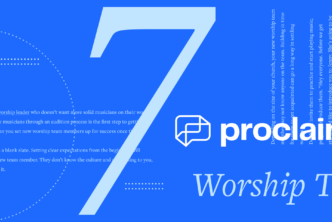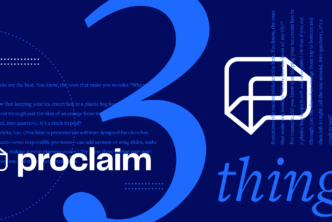One of the easiest ways to spice up your presentations is to choose interesting fonts. But like all good things, fancy fonts become a problem if you abuse them. The result is a distracting jumble of letters that makes it difficult (or impossible) for your audience to discern what’s important—and what’s not.
Here are four ways to fight font clutter in your presentations:
1. Use two, no more than three
A healthy guideline is to limit each slide to two fonts, and to never allow more than three. Like italics or bold text, choosing a second font can be a great way to create contrast. But if you use bold typeface, italics, and underlines, which one of those are you really trying to emphasize? Limiting yourself to two or three fonts can help your audience distinguish between headings, details, and fluff (the words that are good to include, but not absolutely essential to read).
2. RECOGNIZE CAPS-LOCK ABUSE
Putting a word or a phrase in all caps can be an easy, useful way to draw attention to a particular point. All caps says, “THIS IS THE THING YOU NEED TO KNOW.” The point of using caps is to set apart the text, and we’re trained to read phrases or sentences in capital letters similarly to an exclamation, or carefully, like a warning or urgent message.
Imagine reading this whole paragraph in caps. Your brain has learned to read words in all caps slower from years of recognizing the appropriate contexts for all caps, and a whole paragraph of caps makes it difficult to distinguish the important words and phrases. All caps can also indicate that the words following them are important. FOR EXAMPLE: if everything is in caps, nothing is in caps.
3. Avoid script fonts
Script fonts are elegant, fancy, and atrociously hard to read. A slide that helps you articulate your sermon, read a passage, or sing something together as a congregation is not the place for fancy fonts like these. When slides are only visible for seconds at a time, you don’t want people wondering, “Wait, what did that say?” And when you’re preaching, you don’t want everyone to be distracted by how the words look. You want your slides to complement your presentation, and aesthetics can become a distraction. When your goal is to help people follow along, you don’t want your font to become an obstacle. Simply put, there are so few contexts in which script benefits your presentation that you’re better off not using them at all.
4. Choose white on black over black on white
Your projector’s brightest light is white, so white will always be the most visible color you can put on the screen. Most of us can agree that the text itself is the most important part of your slide, and thus, should always be the most visible. If the room is dark, the white light of the text is easily visible, and the words will be most readable. With the right contrast, dark text on a light background can be plenty readable, but on a projector screen, the projector’s light is what matters. Dark text is visible when surrounded by a light background because of the absence of light on the letters. It can definitely work, but when your message matters or you want your congregation to follow along in worship, readability should take precedence over personal preference.
* * *
When you present with Proclaim, professional designers have already optimized your slides for readability. Font clutter isn’t an issue, because the best fonts, styles, and text sizes have been selected for you. Smart Media comes loaded with instructions from our graphic designers, so all you have to do is put your words on the slide, and Proclaim makes sure your message comes through clearly.
Proclaim comes stocked with over $1,000 worth of Smart Media, including beautiful slides and captivating welcome videos. When you try Proclaim free, you get full access on unlimited computers.




